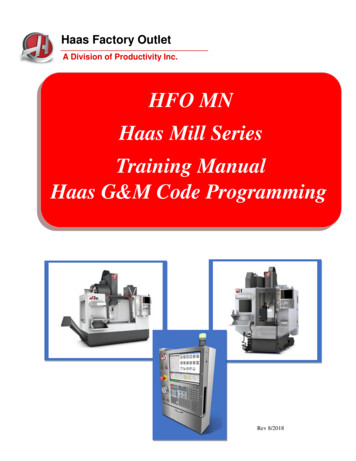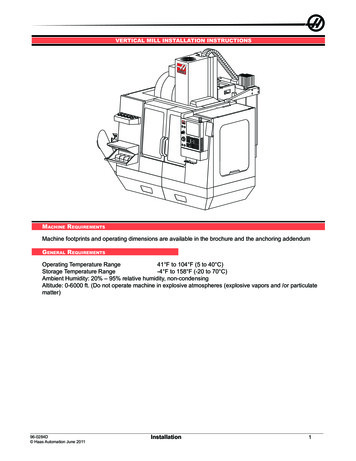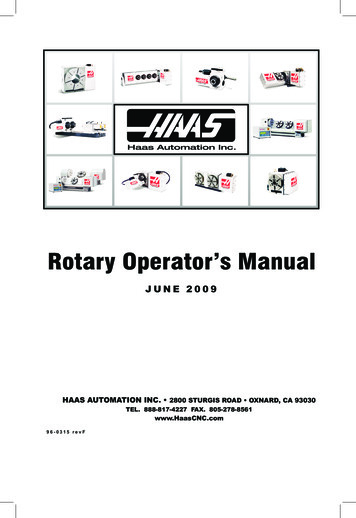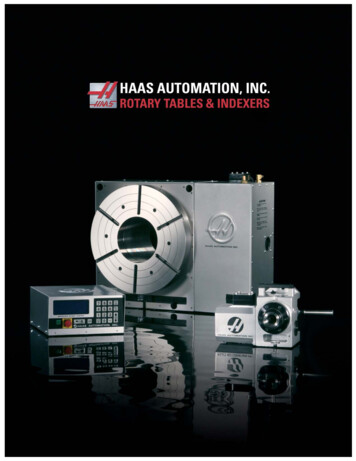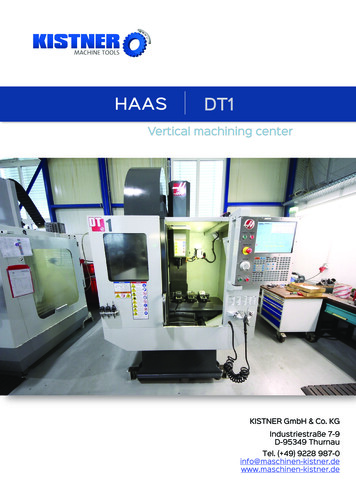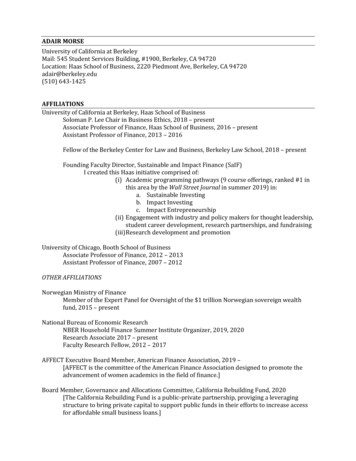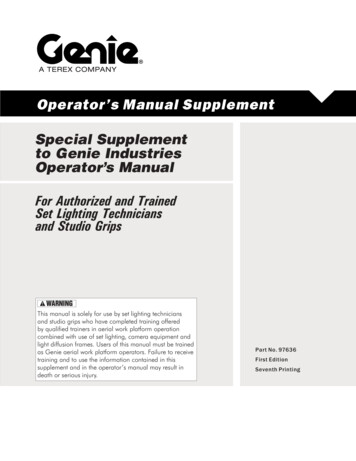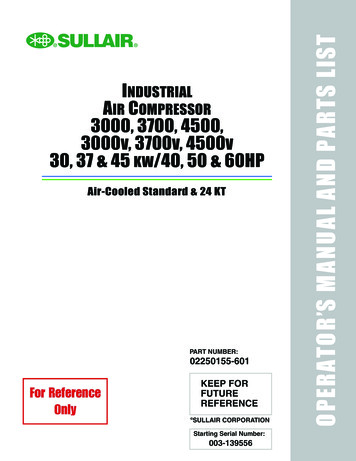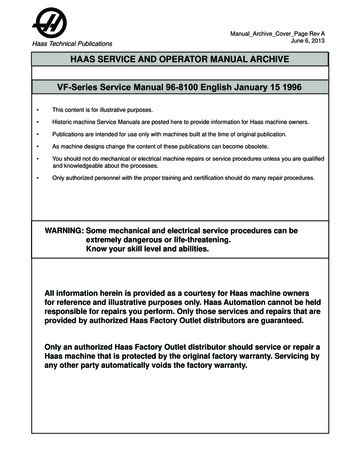
Transcription
Haas Technical PublicationsManual Archive Cover Page Rev AJune 6, 2013HAAS SERVICE AND OPERATOR MANUAL ARCHIVEVF-Series Service Manual 96-8100 English January 15 1996 This content is for illustrative purposes. Historic machine Service Manuals are posted here to provide information for Haas machine owners. Publications are intended for use only with machines built at the time of original publication. As machine designs change the content of these publications can become obsolete. You should not do mechanical or electrical machine repairs or service procedures unless you are qualifiedand knowledgeable about the processes. Only authorized personnel with the proper training and certification should do many repair procedures.WARNING: Some mechanical and electrical service procedures can beextremely dangerous or life-threatening.Know your skill level and abilities.All information herein is provided as a courtesy for Haas machine ownersfor reference and illustrative purposes only. Haas Automation cannot be heldresponsible for repairs you perform. Only those services and repairs that areprovided by authorized Haas Factory Outlet distributors are guaranteed.Only an authorized Haas Factory Outlet distributor should service or repair aHaas machine that is protected by the original factory warranty. Servicing byany other party automatically voids the factory warranty.
VF-S ERIESSERVICETABLE OF CONTENTSTROUBLESHOOTINGM A N U A LTROUBLESHOOTINGThis section is intended for use in determining the solution to a known problem. Solutions given are intended to give theindividual servicing the CNC a pattern to follow in, first, determining the problem s source and, second, solving the problem.The troubleshooting tips are organized in this section according to the area of the CNC that may be giving sign of a problem.(Ex.: Out-of round circles in drilling will be found under the heading General Machine Operation - Accuracy).If the problem you are experiencing cannot be found under the heading you expect, please try several other possible headings. If the problem is still not found, contact Haas Automation for further details.BEFORE YOU BEGIN:USE COMMON SENSEMany problems are easily overcome by correctly evaluating the situation. All machine operations are composed of aprogram, tools, and tooling. You must look at all three before blaming one as the fault area. If a bored hole is chatteringbecause of an overextended boring bar, don t expect the machine to correct the fault. Don t suspect machine accuracy if thevise bends the part. Don t claim hole mis-positioning if you don t first center-drill the hole.FIND THE PROBLEM FIRSTMany mechanics tear into things before they understand the problem, hoping that it will appear as they go. We know thisfrom the fact that more than half of all warranty returned parts are in good working order. If the spindle doesn t turn,remember that the spindle is connected to the gear box, which is connected to the spindle motor, which is driven by thespindle drive, which is connected to the I/O BOARD, which is driven by the computer. The moral here is don t replace thespindle drive if the belt is broken. Find the problem first; don t just replace the easiest part to get to.DON T TINKER WITH THE MACHINEThere are hundreds of parameters, wires, switches, etc., that you can change in this machine. Don t start randomly changingparts and parameters. Remember, there is a good chance that if you change something, you will incorrectly install it or breaksomething else in the process. Consider for a moment changing the processor s board. First, you have to download allparameters, remove a dozen connectors, replace the board, reload and reconnect, and if you make one mistake or bend onetiny pin it WON T WORK. You always need to consider the risk of accidentally damaging the machine anytime you work onit. It is cheap insurance to double-check a suspect part before physically changing it. The less work you do on the machinethe better.1-15-9696-8100HAAS AUTOMATION, INC.1
VF-S ERIESSERVICEM A N U A LTROUBLESHOOTING1. GENERAL MACHINE OPERATION1.1 MACHINE NOT RUNNING Machine cannot be powered on.lllllll Machine can be powered on, but turns off by itself.lllllll lllllReplace Microprocessor PCB (Section 4.1, Electrical Service).Replace VIDEO PCB (see "Electrical Service").Replace MOTIF PCB (see "Electrical Service").Machine turns on, CRT works, but no keyboard keys work.lll2Check for green POWER LED at front of CRT.Check for power connections to CRT from IOPCB.Check video cable (760) from VIDEO PCB to CRT.Replace CRT (see "Electrical Service").Any LED on Microprocessor PCB goes out (except HALT).l Check settings #1 and #2 for Auto Off Timer or Off at M30.Check alarm history for OVERVOLTAGE or OVERHEAT shutdown.Check AC power supply lines for intermittent supply.Check wiring to POWER OFF button on front control panel.Replace IOPCB (see "Electrical Service").Check Parameter 57 for Power Off at E-STOP.Replace MOTIF PCB (see "Electrical Service").Machine turns on, keyboard beeps, but no CRT display.l Check input voltage to machine (see "Electrical Service").Check main circuit breaker at top right of electrical cabinet; switch must be at the on position.Check overvoltage fuses (see "Electrical Service").Check wiring to POWER OFF button on front control panel.Check wiring to AUTO OFF relay to IOPCB.Replace IOPCB (see "Electrical Service").Replace POWER PCB (see "Electrical Service").Check keyboard cable (700) from VIDEO to KBIF PCB.Replace keypad (see "Electrical Service").Replace KBIF PCB (see "Electrical Service").96-8100HAAS AUTOMATION, INC.1-15-96
VF-S ERIESTABLE OF CONTENTSTROUBLESHOOTINGSERVICEM A N U A L1.2 VIBRATIONVibration is a subjective evaluation with perceptions varying among individuals, making it difficult to determine in mildcases if there is an actual problem. Because the VF Series uses a gear head, it will be noisier than a direct drive or beltsystem. In obvious cases, it is a matter of determining the source which is not easy, since all parts rotate together andsound can be transferred readily. Vibrations also need to be distinguished from noise such as a bad bearing. We will assumethat vibrations would be something that could be felt by putting your hand on the spindle covers. One crude method ofmeasurement would be to take an indicator on a magnetic base extended 10 inches between the table and spindle housingand observe the reading of the indicator. A reading of more than .001 would indicate excessive vibration. The two commonsources of noise are the spindle and axis drives. Most complaints about vibration, accuracy, and finish can be attributed toincorrect machining practices such as poor quality or damaged tooling, incorrect speeds or feeds, or poor fixturing. Beforeconcluding that the machine is not working properly, ensure that good machining practices are being observed. Thesesymptoms will not occur individually (Ex. A machine with backlash may vibrate heavily, yielding a bad finish.). Put all of thesymptoms together to arrive at an accurate picture of the problem. Machine vibrates while jogging the axis with the hand wheel.The HAAS control uses very high gain accelerations curves. This vibration as you jog is simply the servos quickly tryingto follow the handle divisions. If this is a problem, try using a smaller division on the handle. You will notice the vibrationmore at individual clicks than when you are turning the handle faster. This is normal.l The machine vibrates excessively in a cut.This is a tough one to call because machining practices come into play. Generally speaking, the least rigid element ofa cut is the tool because it is the smallest part. Any cutter will vibrate if pushed beyond its tensile strength. In order toeliminate the machine as the source of the problem, you need to check the spindle and the backlash of the axes as describedin the following sections. Once machining practices have been eliminated as the source of vibration, observe the machine inboth operation and cutting air. Move the axes (individually) without the spindle turning and then turn the spindle withoutmoving the axes. Isolate whether the vibration comes from the spindle head or from an axis. Isolate the source of vibrationper "Spindle", "Servo Motors/Leadscrews", and "Gearbox and Spindle Motor" sections.l1-15-9696-8100HAAS AUTOMATION, INC.3
VF-S ERIESSERVICEM A N U A LTROUBLESHOOTING1.3 ACCURACYBefore you complain of an accuracy problem, please make sure you follow these simple do s and don ts.l Don t ever use a wiggler test indicator for linear dimensions. They measure in an arc and have sine/cosine errors overlarger distances.l Don t use magnetic bases as accurate test stops. The high accel/decel of the axis can cause them to move.l Don t attach test points to the sheet metal of the spindle head or table.l Don t check for thermal growth with an indicator on a long extension magnetic base.l Do insure that test indicators and stops are absolutely rigid and mounted to machined casting surfaces.l Do check a suspected error with another indicator or method for verification.l Do ensure that the indicator is parallel to the axis being checked to avoid tangential reading errors.l Do center drill holes before using jobber length drills if accuracy is questioned.l Once machining practices have been eliminated as the source of the problem, determine specifically what the machineis doing wrong. ll ll ll l Check the levelness of the machine (See the Installation Manual).Check for backlash ("Servo Motors/Leadscrews" section).Bored holes do not go straight through the workpiece.Check the levelness of the machine (See the Installation Manual).Check for squareness in the Z axis.Machine bores holes out-of-round.Check the levelness of the machine (See the Installation Manual).Check the sweep of the machine ("Spindle Sweep Adjustment").Bored holes are out of round or out of postion.The spindle is not parallel to the Z axis. Check the spindle sweep to the table and the squareness of the Z axis with acylinder square. If available use a spindle master bar and indicate the spindle to the Z axis.Machine mis-positions holes.lCheck the levelness of the machine (See the Installation Manual).Check for backlash ("Servo Motors/Leadscrews").Check the squareness of the X axis to the Y axis. Machine leaves large steps when using a shell mill.lllll4Machine will not interpolate a round hole.Check the levelness of the machine (See the Installation Manual).Check the sweep of the machine ("Spindle Sweep Adjustment").Cutter diameter too large for depth of cut.96-8100HAAS AUTOMATION, INC.1-15-96
VF-S ERIESTABLE OF CONTENTSTROUBLESHOOTING llllllSERVICEM A N U A LBoring depth inaccurate (VF-6)Insufficient counterbalance pressure due to:corrupted hosebad regulatorbad check valveair cylinder badbound cylindersurge tank leak1.4 FINISH llllll1-15-96Machining yields a poor finish.Check for gearbox vibration. This is the most common cause of a poor finish.Check for backlash ("Accuracy/Backlash" section)Check the condition of the tooling and the spindle.Check for spindle failure.Check the condition of the servo motors.Check the machine level.96-8100HAAS AUTOMATION, INC.5
VF-S ERIESSERVICEM A N U A LTROUBLESHOOTING2. SPINDLE2.1 NOT TURNING lllllllllSpindle not turning.If there are any alarms, refer to "Alarms" sectionCheck that the spindle turns freely when machine is off.If motor turns but spindle does not, see "Belt Assembly" and "Spindle Motor & Transmission" sections.Command spindle to turn at 1800 RPM and check spindle drive display. If display blinks bb , check spindle orientation switch ("Spindle Orientation" section). If spindle drive does not light the RUN LED, check forward/reversecommands from IOPCB ("Electrical Service").Check the wiring of analog speed command from MOTIF PCB to spindle drive (cable 720).If spindle is still not turning, replace MOTIF PCB ("Electrical Service").If spindle is still not turning, replace spindle drive ("Electrical Service").Check for rotation of the gearbox (VF-1, VF-2, VF-3) or the motor (VF-0). If the motor or gearbox operates, check thedrive belt ("Belt Assembly" section).Disconnect the drive belt. If the spindle will not turn, it is seized and must be replaced ("Spindle Assembly" section).NOTE: Before using the replacement spindle, the cause of the previous failure must be determined.2.2 NOISEMost noises attributed to the spindle actually lie in the motor/gearbox or drive belt of the machine. Isolate the sources ofnoise as follows: Excessive noise coming from the spindle head area.On VF-1 through 6 models, first determine if the noise is related to the RPM of the motor or the RPM of the spindle. Forexample: If the noise appears at 2000 RPM in high gear, listen for a similar noise at 500 RPM in low gear. If the same noisepersists, the problem lies with the gearbox. If the noise disappears, the problem could be either the gearbox or the spindle,and further testing is necessary.llll6Remove the head covers and check the machine s drive belt tension ("Tension Adjustment" section).Ø If the noise persists, turn the drive belt over on the pulleys. If the noise is significantly different, the beltis at fault. Replace the belt ("Belt Assembly" section).Ø If the noise does not change, remove the belt and go on to the next step.Check the pulleys for excessive runout (more than 0.003" axial or radial).Run the motor (VF-0) or the gearbox (VF-1, VF-2, VF-3) with the drive belt disconnected. If the noise persists,the problem lies with the gearbox/motor. If it disappears, go on to the next step.Check for the correct amount of lubrication to the spindle bearings (0.5-1.0 cc every two hours) in a an air mistlubricated spindle.Ø If the spindle is not getting lubrication, correct the problem per the lube and air diagram at the back of thismanual and replace the spindle ("Spindle Assembly" section).Ø If the spindle is gettin
HAAS SERVICE AND OPERATOR MANUAL ARCHIVE WARNING: Some mechanical and electrical service procedures can be extremely dangerous or life-threatening. Know your
